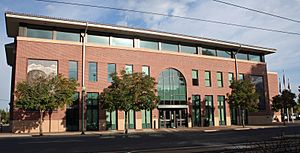Blair-Caldwell African American Research Library facts for kids
Quick facts for kids Blair-Caldwell African American Research Library |
|
|---|---|
 |
|
| The library in Five Points, Denver. | |
| Country | United States |
| Type | Public library and research library |
| Established | 2003 |
| Location | 2401 Welton Street Denver CO 80205 |
| Coordinates | 39°45′09″N 104°58′53″W / 39.7524°N 104.9815°W |
| Branch of | Denver Public Library |
| Collection | |
| Items collected | All formats |
| Access and use | |
| Population served | Five Points neighborhood |
| Phone number | (720) 865-2401 |
The Blair-Caldwell African American Research Library is a special library in Denver, Colorado. It's part of the Denver Public Library system. This library opened in 2003 in the Five Points neighborhood. It's not just a regular library; it's also a research center. Its main goal is to collect and save the history of African Americans in Denver and the American West.
Many people visit the library each year. In 2017, about 135,000 visitors came, including school groups. They often visit the museum on the third floor. The library's mission is to "collect and preserve the history and culture of African Americans in Colorado and throughout the Rocky Mountain West."
Contents
Discovering the Library's History
How the Idea Began
The idea for this library started in 1999. It came from Wellington Webb, who was Denver's first African American mayor, and his wife, Wilma Webb. They noticed that the history of African Americans in Denver and the American West wasn't well-known. They wanted to create a place where young people, especially those of African descent, could learn about their heritage in the West.
The Five Points neighborhood was chosen for the library. This area has a rich history and is also home to the Black American West Museum. Construction began in early 2002, and the library officially opened on April 26, 2003. As of 2017, it was one of only four African American research libraries in the entire country.
Why This Library Is Important
Wellington and Wilma Webb were worried that important stories and contributions of African Americans in Colorado and the West might be lost. Much of this history was kept in private homes or had not been written down. They wanted to make sure these stories were saved for future generations.
Mayor Webb said, "There’s so much history, and we need to capture that for young people. So much of it is in boxes, in basements, or in our heads." In 2000, the Denver library staff started gathering items. They collected personal papers, photos, artworks, and other special items from important African Americans. Many donations came from across Colorado, and Mayor Webb even gave many items from his own collection.
Honoring Important Leaders
The library was named the Blair-Caldwell African American Research Library. This name honors two important African American leaders from Denver: Omar Blair and Elvin Caldwell.
Omar Blair was a brave officer in World War II. He was one of the famous Tuskegee Airman. In 1973, he became the first black president of the Denver school board. He is best remembered for helping to end segregation in Denver’s schools.
Elvin Caldwell made history in 1955. He was elected Denver’s first black city council member. This made him the first African American city council member west of the Mississippi River. He served on the Denver city council for 28 years. He even spent five years as its president. Elvin Caldwell worked hard to fight unfair treatment in the Denver police and fire departments. He also helped with economic growth and housing, and he was a strong supporter of Denver’s children.
Exploring the Library's Collections
The Blair-Caldwell African American Research Library is a large building with three floors. It covers about 40,000 square feet.
First Floor: Your Local Library
The first floor is like a regular branch of the Denver Public Library. It has an entrance area and places to see exhibits. You'll find rooms for meetings, studying, and events. This floor has over 35,000 books, magazines, and movies. These materials are available in both English and Spanish.
Second Floor: Research and Archives
The second floor is where the special research collections are kept. This area includes:
- Rare books
- Old photographs, handwritten papers, and diaries
- Historic newspapers
- Areas to listen to and watch oral histories (people telling their stories)
- Research papers and doctoral theses on microfilm
- Spaces for research and study
- Storage for historical records
- A gallery for programs by musicians, artists, and scholars.
This floor also has changing exhibits of historical items. As of 2018, you could access over 90 collections of historical records digitally.
Third Floor: The Museum Experience
The third floor is a 7,000-square-foot museum. It has exhibits about the history of African Americans in Denver and the Western United States. The stories here cover a long time, starting in the 16th century Southwest and stretching from Mexico to Canada.
One very special item in the museum is the original 1834 manumission papers. These documents show that Robert Smith, an enslaved person from Virginia, and his family were set free.
The museum also displays the desk that Wellington Webb used when he was Denver's mayor. There's a tribute to Denver’s past mayors and a history of the Five Points neighborhood. This history shows how Five Points changed from a wealthy suburb to a lively center for Denver's black community, and now to a diverse neighborhood. The third floor also has the Charles and Dorothy Cousins Changing Gallery. This gallery shows art from local Denver artists and national exhibits.
Tours and Walking Adventures
The library offers tours and speaking events for groups. You can also take a self-guided walking tour outside the library. This tour is part of the Welton Street Cultural District. It has signs with pictures that tell the story of African Americans in Colorado.

